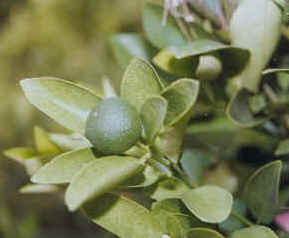
Calamondin
Source: PROSEA - PCARRD
Citrus
Cultivars: Calamondin, Citron, Grapefruit, Lemon, Lime, Mandarin, Orange, Tangerine, and many more hybrids
Scientific name:
Citrus spp.
Family: Rutaceae
Weeds
Grasses
Sedges
Broadleaf
Diseases
Fungal
Bacterial
Viral
Agro-ecology
Planting early-maturing
intercrops (such as legumes, tomatoes, and melons) provides income for the first three years when citrus plants are young. Soybean is the most suitable intercrop followed by pigeon pea and cow pea, based on their nutritional requirements and incidence of insect pests (NRCC, 2003). Do not plant intercrops close to the trees. After harvest, leave crop residues in the field as
mulch. Place mulch at least 5 cm thick and 20 cm away from the base of the tree. Mulch should not be in
contact with the trunk to prevent trunk from rotting. Other mulch materials are dried grasses and rice straw. Mulching conserves moisture during the dry season, prevents weed growth, and provides organic matters when decomposed.
Fertilizer recommendations based on
soil analysis provide the very best chance of getting the right amount of fertilizer without over or under fertilizing. However in the absence of soil analysis, the following is one of the general fertilizer guides:
- Apply compost at 10-15 kg, or cattle manure at 5-6 kg, or 3-4 kg poultry dung on each planting hole as basal fertilizer (FADINAP, 2000: pp. 111).
- In acidic soil, liming is necessary at œ kg of rock phosphate/plant (
Klien, 2000). Mix lime with organic fertilizer to speed up decomposition of organic matter and to save labor cost.
- A month after transplanting, apply 200 grams of urea/tree/year for the first 3 years. Split the applications, during the onset and before the end of the rainy seasons (DA, 2002).
- During fruit development, sidedress with a complete fertilizer (NPK) at a rate of œ -1 kg/tree (FFTC, 2003).
Prune the tree only to remove the inward growing branches, parasites and pests infested stems, and dead wood. While
pruning, be careful not to give damage to the plant. However, avoid heavy pruning as it will delay production since citrus has small reserves of carbohydrates.
Further information
There is a high potential for the use of botanical plant extracts to control citrus pests. Scientific researches has been conducted on plant oils as botanical pesticides.
A study entitled 'Efficacy of an extract of Dorrigo pepper against two-spotted mite and greenhouse thrips' was conducted both in the laboratory and in the greenhouse. Dorrigo pepper (Tasmannia spitata) oil extract by solvent was tested for its bio-efficacy against mites and thrips. When thrips infested leaves of lemon were dipped in the extract at .06% concentration, 100% mortality was recorded 1 day after treatment. The result showed that Dorrigo pepper extract had high efficacy against thrips and had a potential as a natural pesticide (Basta; Spooner-Hart, 2003).
Another
study entitled 'Evaluation of rapeseed based plant oils for control of citrus leafminer and their phytotoxitiy to lemon' was conducted to compare rapeseed oils with horticultural mineral oils. Assessments were based on flushes removed from the trees 1 week after the last application of sprays. Results showed that the mean percentage ranges from a 71%- 96% reduction of leafminer infestation when plant oils were used (Beattie; Jacas; Nicetic; Watson, 2003).
External links
References
- Basta, A.; Spooner-Hart, R. (2003): Efficacy of an extract of Dorrigo pepper (Tasmannia stipitata ) against two-spotted mite and greenhouse thrips. Spray Oils Beyond 2000: Sustainable Pest and Disease Management. eds: G.A.C. Beattie and D.M. Watson. ACIAR.Canberra.
- Beattie, A. (1990): Citrus petroleum spray oils. Agfact H2. AE.5., Department of Agricultural Sciences, Department of Agriculture. New South Wales, Australia.
- Beattie, A. et.al. (2002): Evaluation of rapeseed-based plant oils for control of citrus leafminer and their phytotoxicity to lemon. In: Spray Oils Beyond 2000. University of Western Sydney.
- DA. (2002): Technoguide for citrus production. DA-CAR. Benguet, Philippines.
- Klien, T. (2000): Grow organic citrus. Creative Marketeam, Suite University. Canada.
- Ploetz, R.; et. al. Editors. (1998): Compendium of tropical fruit diseases. APS Press, The American Phytopathological Society. Saint Paul, Minnesota, USA.
- Samson, JA. (1989): Tropical fruits. 2nd edition. Longman Singapore Publishers. Singapore.
- Thurston, D. (1998): Tropical plant diseases. Second Edition. APS Press. The American Phytopathological Society. St. Paul, Minnesota, USA.

